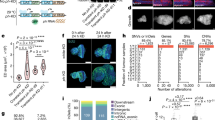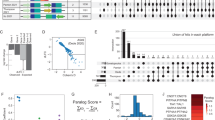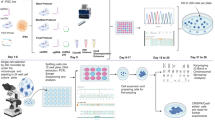Abstract
Telomeres in most immortal cells1,2,3 are maintained by the enzyme telomerase4, allowing cells to divide indefinitely. Some telomerase-negative tumors and immortal cell lines maintain long heterogeneous telomeres by the ALT (alternative lengthening of telomeres) mechanism5,6; such tumors are expected to be resistant to anti-telomerase drug therapies. Occasionally telomerase-negative Saccharomyces cerevisiae mutants survive, and 10% of them (type II survivors) have unstable telomeres7,8. As in human ALT+ cells9, short telomeres in yeast type II survivors lengthen abruptly; in yeast, this is dependent on the recombination proteins Rad52p and Rad50p10. In human cells, ALT involves copying of sequence from a donor to a recipient telomere11. We have characterized for the first time a class of complex telomere mutations seen only in ALT+ cells. The mutant telomeres are defined by the replacement of the progenitor telomere at a discrete point (fusion point) with a different telomere repeat array. Among 19 characterized fusion points, one occurred within the first six repeats of the telomere, indicating that these recombination-like events can occur anywhere within the telomere. One mutant telomere may have been involved in a secondary recombination-like mutation event, suggesting that these mutations are sporadic but ongoing in ALT+ cells. We also identified simple intra-allelic mutations at high frequency, which evidently contribute to telomere instability in ALT+ cells.
This is a preview of subscription content, access via your institution
Access options
Subscribe to this journal
Receive 12 print issues and online access
$209.00 per year
only $17.42 per issue
Buy this article
- Purchase on Springer Link
- Instant access to full article PDF
Prices may be subject to local taxes which are calculated during checkout



Similar content being viewed by others
References
Morin, G.B. The human telomere terminal transferase enzyme is a ribonucleoprotein that synthesizes TTAGGG repeats. Cell 59, 521–529 (1989).
Kim, N.W. et al. Specific association of human telomerase activity with immortal cells and cancer. Science 266, 2011–2015 (1994).
Wright, W.E., Piatyszek, M.A., Rainey, W.E., Byrd, W. & Shay, J.W. Telomerase activity in human germline and embryonic-tissues and cells. Dev. Genet. 18, 173–179 (1996).
Greider, C.W. & Blackburn, E.H. Identification of a specific telomere terminal transferase activity in Tetrahymena extracts. Cell 43, 405–413 (1985).
Bryan, T.M., Englezou, A., Gupta, J., Bacchetti, S. & Reddel, R.R. Telomere elongation in immortal human cells without detectable telomerase activity. EMBO J. 14, 4240–4248 (1995).
Bryan, T.M., Englezou, A., Dalla-Pozza, L., Dunham, M.A. & Reddel, R.R. Evidence for an alternative mechanism for maintaining telomere length in human tumors and tumor-derived cell lines. Nature Med. 3, 1271–1274 (1997).
Lundblad, V. & Blackburn, E.H. An alternative pathway for yeast telomere maintenance rescues est1- senescence. Cell 73, 347–360 (1993).
Teng, S.C. & Zakian, V.A. Telomere-telomere recombination is an efficient bypass pathway for telomere maintenance in Saccharomyces cerevisiae. Mol. Cell. Biol. 19, 8083–8093 (1999).
Murnane, J.P., Sabatier, L., Marder, B.A. & Morgan, W.F. Telomere dynamics in an immortal human cell line. EMBO J. 13, 4953–4962 (1994).
Teng, C.S., Chang, J., McCowan, B. & Zakian, A.V. Telomerase-independent lengthening of yeast telomeres occurs by an abrupt Rad50p-dependent, Rif-inhibited recombinational process. Mol. Cell 6, 947–952 (2000).
Dunham, M.A., Neumann, A.A., Fasching, C.L. & Reddel, R.R. Telomere maintenance by recombination in human cells. Nature Genet. 26, 447–450 (2000).
Allsopp, R.C. et al. Telomere length predicts replicative capacity of human fibroblasts. Proc. Natl Acad. Sci. USA 89, 10114–10118 (1992).
Allsopp, R.C. & Harley, C.B. Evidence for a critical telomere length in senescent human fibroblasts. Exp. Cell Res. 219, 130–136 (1995).
Counter, C.M. et al. Telomere shortening associated with chromosome instability is arrested in immortal cells which express telomerase activity. EMBO J. 11, 1921–1929 (1992).
Counter, C.M., Botelho, F.M., Wang, P., Harley, C.B. & Bacchetti, S. Stabilization of short telomeres and telomerase activity accompany immortalization of Epstein-Barr virus-transformed human B lymphocytes. J. Virol. 68, 3410–3414 (1994).
Bryan, T.M. & Reddel, R.R. Telomere dynamics and telomerase activity in in vitro immortalised human cells. Eur. J. Cancer 33, 767–773 (1997).
Allshire, R.C., Dempster, M. & Hastie, N.D. Human telomeres contain at least three types of G-rich repeat distributed non-randomly. Nucleic Acids Res. 17, 4611–4627 (1989).
Baird, D.M., Jeffreys, A.J. & Royle, N.J. Mechanisms underlying telomere repeat turnover, revealed by hypervariable variant repeat distribution patterns in the human X/Yp telomere. EMBO J. 14, 5433–5443 (1995).
Baird, D.M., Coleman, J., Rosser, Z.H. & Royle, N.J. High levels of sequence polymorphism and linkage disequilibrium at the telomere of 12q: implications for telomere biology and human evolution. Am. J. Hum. Genet. 66, 235–250 (2000).
Coleman, J., Baird, D.M. & Royle, N.J. The plasticity of human telomeres demonstrated by a hypervariable telomere repeat array that is located on some copies of 16p and 16q. Hum. Mol. Genet. 8, 1637–1646 (1999).
Yeager, T.R. et al. Telomerase-negative immortalized human cells contain a novel type of promyelocytic leukemia (PML) body. Cancer Res. 59, 4175–4179 (1999).
Rizki, A. & Lundblad, V. Defects in mismatch repair promote telomerase-independent proliferation. Nature 411, 713–716 (2001).
Warneford, S.G. et al. Germ-line splicing mutation of the p53 gene in a cancer-prone family. Cell Growth Differ. 3, 839–846 (1992).
Rogan, E.M. et al. Alterations in p53 and p16INK4 expression and telomere length during spontaneous immortalization of Li-Fraumeni syndrome fibroblasts. Mol. Cell. Biol. 15, 4745–4753 (1995).
Ford, L.P. et al. Telomerase can inhibit the recombination-based pathway of telomere maintenance in human cells. J. Biol. Chem. 276, 32198–32203 (2001).
Bryan, T.M., Marusic, L., Bacchetti, S., Namba, M. & Reddel, R.R. The telomere lengthening mechanism in telomerase-negative immortal human cells does not involve the telomerase RNA subunit. Hum. Mol. Genet. 6, 921–926 (1997).
Jeffreys, A.J., Macleod, A., Tamaki, K., Neil, D.L. & Monckton, D.G. Minisatellite repeat coding as a digital approach to DNA typing. Nature 354, 204–209 (1991).
Baird, D.M. & Royle, N.J. Sequences from higher primates orthologous to the human Xp/Yp telomere junction region reveal gross rearrangements and high levels of divergence. Hum. Mol. Genet. 6, 2291–2299 (1997).
Acknowledgements
We thank A.J. Jeffreys and C. May for their valuable comments on the manuscript. The work was funded by a UK Medical Research Council component group grant (to N.J.R.) and funding (to R.R.) from the Carcinogenesis Fellowship of the New South Wales Cancer Council. H.A.P. was supported by a UK-MRC studentship.
Author information
Authors and Affiliations
Corresponding author
Rights and permissions
About this article
Cite this article
Varley, H., Pickett, H., Foxon, J. et al. Molecular characterization of inter-telomere and intra-telomere mutations in human ALT cells. Nat Genet 30, 301–305 (2002). https://doi.org/10.1038/ng834
Received:
Accepted:
Published:
Issue Date:
DOI: https://doi.org/10.1038/ng834
This article is cited by
-
Alternative lengthening of telomeres (ALT) cells viability is dependent on C-rich telomeric RNAs
Nature Communications (2023)
-
Reliable assessment of telomere maintenance mechanisms in neuroblastoma
Cell & Bioscience (2022)
-
The absence of (TCAGGG)n repeats in some telomeres, combined with variable responses to NR2F2 depletion, suggest that this nuclear receptor plays an indirect role in the alternative lengthening of telomeres
Scientific Reports (2020)
-
Genomic footprints of activated telomere maintenance mechanisms in cancer
Nature Communications (2020)
-
TelomereHunter – in silico estimation of telomere content and composition from cancer genomes
BMC Bioinformatics (2019)



